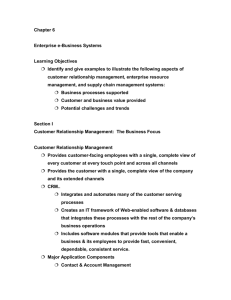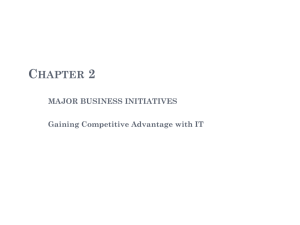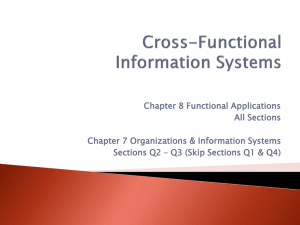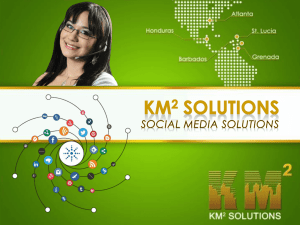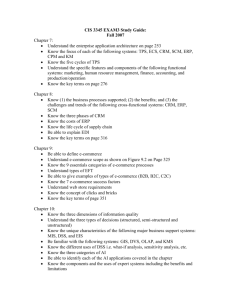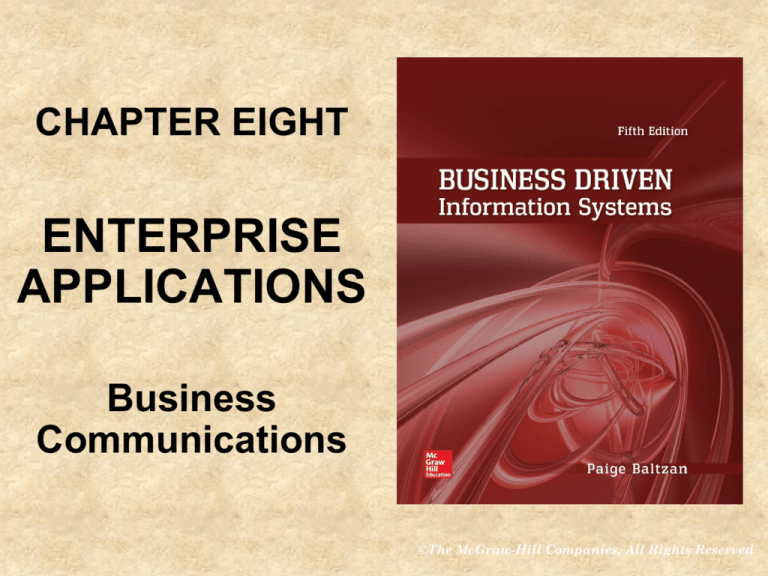
CHAPTER EIGHT
ENTERPRISE
APPLICATIONS
Business
Communications
©The McGraw-Hill Companies, All Rights Reserved
2
CHAPTER OVERVIEW
SECTION 8.1 – Enterprise Systems and Supply Chain
Management
• Building a Connected Corporation Through Integrations
• Supply Chain Management
• Technologies Reinventing the Supply Chain
SECTION 8.2 – Customer Relationship Management
and Enterprise Resource Planning
•
•
•
•
Customer Relationship Management
The Benefits of CRM
Enterprise Resource Planning
Organizational Integration with ERP
SECTION 8.1
Supply Chain
Management
©The McGraw-Hill Companies, All Rights Reserved
4
LEARNING OUTCOMES
1. Explain integrations and the role they play in
connecting a corporation
2. Describe supply chain management along
with its impact on business
3. Identify the three technologies that are
reinventing the supply chain
5
BUILDING A CONNECTED CORPORATION
THROUGH INTEGRATIONS
Integration – Allows separate systems
to communicate directly with each
other, eliminating the need for manual
entry into multiple systems
• Application integration
• Data integration
• Forward integration
• Backward integration
6
BUILDING A CONNECTED CORPORATION
THROUGH INTEGRATIONS
Integration Example
7
BUILDING A CONNECTED CORPORATION
THROUGH INTEGRATIONS
A Central Information Repository Example
8
Integration Tools
Enterprise system – Provide
enterprisewide support and
data access for a firm’s
operations and business
processes
Enterprise application
integration (EAI) – Connects
the plans, methods, and tools
aimed at integrating separate
enterprise systems
9
Integration Tools
Middleware – Several different types
of software that sit between and
provide connectivity for two or more
software applications
Enterprise application integration
middleware – Takes a new approach
to middleware by packaging commonly
used applications together, reducing
the time needed to integrate
applications from multiple vendors
10
Integration Tools
Three Primary Enterprise Systems
11
SUPPLY CHAIN MANAGEMENT
Five basic supply
chain activities
12
SUPPLY CHAIN MANAGEMENT
Supply Chain Management (SCM) – The management
of information flows between and among activities in a
supply chain to maximize total supply chain effectiveness
and profitability
13
SUPPLY CHAIN MANAGEMENT
The supply chain has three main links
1. Materials flow from suppliers and their
“upstream” suppliers at all levels
2. Transformation of materials into
semifinished and finished products
through the organization’s own production
process
3. Distribution of products to customers and
their “downstream” customers at all levels
14
SUPPLY CHAIN MANAGEMENT
Supply Chain Example
15
SUPPLY CHAIN MANAGEMENT
Walmart and Procter & Gamble SCM Example
16
SUPPLY CHAIN MANAGEMENT
Effective and efficient SCM systems can enable
an organization to
• Decrease the power of its buyers
• Increase its own supplier power
• Increase switching costs to reduce the threat of
substitute products or services
• Create entry barriers thereby reducing the threat of
new entrants
• Increase efficiencies while seeking a competitive
advantage through cost leadership
17
SUPPLY CHAIN MANAGEMENT
Effective and Efficient SCM Systems
Effect on Porter’s Five Forces
18
Visibility into the Supply Chain
Supply chain visibility – The ability to
view all areas up and down the supply
chain in real time
• Supply chain planning system
• Supply chain execution system
• Bullwhip effect
19
Visibility into the Supply Chain
Supply Chain Planning and Execution
20
TECHNOLOGIES REINVENTING
THE SUPPLY CHAIN
The three components of supply chain
management
• Procurement
• Logistics
• Materials management
21
TECHNOLOGIES REINVENTING
THE SUPPLY CHAIN
Supply chain management disruptive
technologies
• 3D printing (supports procurement)
Maker movement
Makerspace
• Radio frequency identification (supports
logistics)
• Drones (supports logistics)
• Robotics (supports materials management)
22
The Extended Supply Chain
The fastest growing extensions for supply
chain management include:
• Supply chain event management (SCEM)
• Selling chain management
• Collaborative engineering
• Collaborative demand planning
SECTION 8.2
Customer
Relationship
Management and
Enterprise
Resource
Planning
©The McGraw-Hill Companies, All Rights Reserved
24
LEARNING OUTCOMES
4. Explain operational and analytical customer
relationship management
5. Identify the core and extended areas of
enterprise resource management
6. Discuss the current technologies organizations
are integrating in enterprise resource planning
systems
25
CUSTOMER RELATIONSHIP
MANAGEMENT
Customer relationship management (CRM) –
Involves managing all aspects of a customer’s
relationship with an organization to increase
customer loyalty and retention and an
organization's profitability
Many organizations, such as Charles Schwab and
Kaiser Permanente, have obtained great success
through the implementation of CRM systems
26
THE BENEFITS OF CRM
Organizations can find their most valuable
customers through “RFM” - Recency,
Frequency, and Monetary value
• How recently a customer purchased items
• How frequently a customer purchased items
• The monetary value of each customer
purchase
27
The Power of The Customer
The customer is
always right and
now has more
power than ever
thanks to the
Internet
28
Measuring CRM Success
29
CRM Communication Channels
Text message
Instant message
Voice mail
Voice call
Email letter
Web order
Phone order
Meeting
Customer service call
Twitter
Facebook
30
Evolution of CRM
CRM reporting technology – Help organizations
identify their customers across other applications
CRM analysis technologies – Help organization
segment their customers into categories such as
best and worst customers
CRM predicting technologies – Help
organizations make predictions regarding
customer behavior such as which customers are
at risk of leaving
31
Evolution of CRM
32
Operational and Analytical CRM
Operational CRM – Supports
traditional transactional processing for
day-to-day front-office operations or
systems that deal directly with the
customers
Analytical CRM – Supports backoffice operations and strategic
analysis and includes all systems that
do not deal directly with the customers
33
Operational and Analytical CRM
34
Operational and Analytical CRM
Marketing and operational CRM technology
• List generator, campaign management, cross-selling
and up-selling
Sales and operational CRM technology
• Sales management, contact management,
opportunity management
Customer service and operational CRM
technology
• Contact center, Web-based self-service, call scripting
35
Marketing and Operational CRM
Three marketing operational CRM
technologies
1. List generator
2. Campaign management system
3. Cross-selling and up-selling
36
Sales and Operational CRM
The sales department was the first to begin
developing CRM systems with sales force
automation a system that automatically tracks all
of the steps in the sales process
37
Sales and Operational CRM
Sales and operational CRM technologies
1. Sales management CRM system
2. Contact management CRM system
3. Opportunity management CRM system
38
Customer Service and
Operational CRM
Three customer service operational CRM
technologies
1. Contact center (call center)
2. Web-based self-service system
3. Call scripting system
Common features included in contact centers
• Automatic call distribution
• Interactive voice response
• Predictive dialing
39
Analytical CRM
Website personalization – Occurs when a
website has stored enough data about a person’s
likes and dislikes to fashion offers more likely to
appeal to that person
•
Analytical CRM relies heavily on data warehousing
technologies and business intelligence to glean
insights into customer behavior
•
These systems quickly aggregate, analyze, and
disseminate customer information throughout an
organization
40
Extending CRM
Current trends include
•
Supplier relationship management (SRM)
•
Partner relationship management (PRM)
•
Employee relationship management (ERM)
41
ENTERPRISE RESOURCE
PLANNING
Enterprise resource planning – Integrates all
departments and functions throughout an
organization into a single IT system (or
integrated set of IT systems) so that employees
can make enterprisewide decisions by viewing
enterprisewide information on all business
operations
42
ENTERPRISE RESOURCE
PLANNING
Reasons ERP systems are
powerful tools
• ERP is a logical solution to
incompatible applications
• ERP addresses global information
sharing and reporting
• ERP avoids the pain and expense
of fixing legacy systems
43
ENTERPRISE RESOURCE
PLANNING
ERP systems collect data from across an
organization and correlates the data generating
an enterprisewide view
44
ENTERPRISE RESOURCE
PLANNING
ERP Systems Automate Business Processes
45
ENTERPRISE RESOURCE
PLANNING
The Organization Before ERP
46
ENTERPRISE RESOURCE
PLANNING
ERP Bringing The Organization Together
47
THE BENEFITS OF ERP
Core ERP component – Traditional
components included in most ERP systems and
they primarily focus on internal operations
Extended ERP component – Extra
components that meet the organizational needs
not covered by the core components and
primarily focus on external operations
48
THE BENEFITS OF ERP
49
THE BENEFITS OF ERP
50
Core ERP Components
Three most common core ERP
components
1. Accounting and finance
2. Production and materials management
3. Human resource
51
Accounting and Finance ERP Components
Accounting and finance
ERP component –
Manages accounting data
and financial processes
within the enterprise with
functions such as general
ledger, accounts payable,
accounts receivable,
budgeting, and asset
management
52
Production and Materials Management ERP
Components
Production and
materials
management ERP
component – Handles
the various aspects of
production planning and
execution such as
demand forecasting,
production scheduling,
job cost accounting,
and quality control
53
Human Resource ERP Component
Human resource ERP
component – Tracks
employee information
including payroll, benefits,
compensation, performance
assessment, and assumes
compliance with the legal
requirements of multiple
jurisdictions and tax
authorities
54
Extended ERP Components
Extended ERP components include:
• Business intelligence
• Customer relationship management
• Supply chain management
• Ebusiness components include
Elogistics
Eprocurement
55
Measuring ERP Success
Balanced scorecard – Enables organizations
to clarify their vision and strategy and translate
them into action
Balanced scorecard views the organization from
four perspectives
• Learning and growth
• Internal business process
• Customer
• Financial
56
Measuring ERP Success
57
Measuring ERP Success
ERP systems contain multiple complex
components that are not only expensive to
purchase, but also expensive to implement
Costs include
•
•
•
•
•
•
Software
Consulting fees
Process rework
Customization
Integration
Testing/Training
58
ORGANIZATIONAL INTEGRATION WITH ERP
SCM, CRM, and ERP are the
backbone of ebusiness
Integration of these applications is
the key to success for many
companies
Integration allows the unlocking of
information to make it available to
any user, anywhere, anytime
59
ORGANIZATIONAL INTEGRATION WITH ERP
60
LEARNING OUTCOME REVIEW
Now that you have finished the chapter
please review the learning outcomes in
your text




